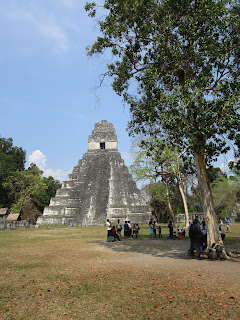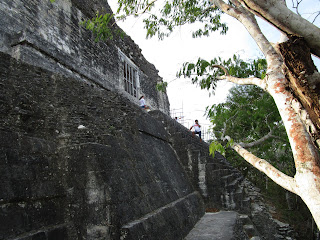 |
| Tikal's Grand Square. Basically, downtown Tikal. |
Tikal was the largest and grandest of the Mayan cities of Mesoamerica. At its peak, it may have been home to as many as 200,000 people. It may have been, at its peak, possibly the second largest city in the world. (Beijing was probably always bigger.) And that's where my tourism-travel adventures take me today: Tikal.
Welcome to Tikal.
This is the Ceiba tree. Or maybe merely a Ceiba tree,
Again, Tikal is rather large. Basically, I walked a city the size of Rochester, New York. Or Akron, Ohio. Or Little Rock, Arkansas. In an afternoon. No wonder my feet are sore.
I'm not going to comment too specifically on any one sight I saw. I don't recognize the various temples by their assigned numbers. And the grandeur of the place isn't any one specific point. It's the entirety of the place.
Tikal existed for a baktun. Yes, I am showing off my knowledge of Mayan lore.
A baktun is a 400-year cycle, a cycle of 20 katun on the Mayan long count calendar.
Tikan lasted for a baktun: A.D. 400 to A.D. 800. It limped on for a little after that, but it's prime (and time of all of the construction you see in these photos) was during that baktun.
Here's a fun fact. (Well, my idea of fun.) The Mayan counting system was based on "base 20," not "base 10" like every Western counting system. And the Mayans of the triple digit years A.D. were one of only two civilizations of the planet whose numbering system included a zero. The Mayans and India. That's it. Not even the super-sophisticated Romans and Greeks had a zero in their counting system. The Mayan did.
What I don't understand about Tikal is why is this not a major tourist attraction?
Everybody, including this guy, wants to go to Machu Picchu, for example.
But Tikal is a 1000 years older.
This is a restored face that decorated the now-restored temple on which you find this face.
Tikal is older than Machu Picchu. It is bigger than Machu Picchu. And it's a considerably shorter flight from the United States.
So why is Machu Picchu on everyone's so-called bucket list, while Tikal totters in anonymity?
I know: marketing. But sights like this should be a piece o' cake to market:
The people in the foreground give you an idea of the scale.
And keep in mind this was built well over a millennium ago, maybe even a millennium and a half.
This pyramid dates from the Calakmul occupation of Tikal.
Calakmul was a Mayan city-state in the southern Yucatan who was Tikal's arch-rival, or arch-nemesis. Think Athens and Sparta. Calakmul would be the Sparta in that analogy, in that it was more war-like.
So says the apologist for Tikal. Still, you would not go wrong analogizing the Mayan world of Mesoamerica to the Greek system of city-states, while the Aztecs of Mexico (who came along much later) could be analogized to the Roman Empire (which also came along after the decline of Greece), with its centralized control, and imposition of a single language.
What you see is a mix of original and "restored."
Much has been degraded in the intervening 1500 years. But, then again, think of how much "original" construction is still standing in Athens or Rome.
And I did actually see a toucan. In the wild. It is visible at the top part of the photo below, near the center:
Wildlife sighting here were plentiful.
And the last new construction here (not counting restoration currently taking place) probably dates from the late 700's.
And I don't know why I am using the word "probably." The Mayans dated everything, right down to the specific day, using their sophisticated "long count" calendar. So if something says it was dated December 8, 791, that is an accurate date.
One quick word about the Mayan long count calendar supposedly predicting that the world would end on December 22, 2012. No. The Mayans never ever said that.
December 22, 2012, was the end of a calendar cycle. Key word: cycle. Unlike us Westerners who see time as linear, moving ever forward into the future, the Mayans saw time as circular. Like the movement of the earth through the solar system, for example.
Family selfie on one pyramid-temple:
So many of the pyramid-temples are so degraded that, to this day, they appear to be an odd-shaped mound of dirt.
Trust me, there's a small pyramid under there.
More pictures of people taking pictures:
And here's a pregnant coati:
Her big belly does not mean she's from Milwaukee and has been living on a diet of beer and extra sharp cheddar. It means she's on the nest.
At this point, I climbed a pyramid. I told the guide I would climb one (and only one). He chose Temple IV.
And there was a different coati greeting us at the top.
Technically, it was not the top-top of the pyramid.
But to ascend any higher, you would have had to be a priest, a king, or a sacrifice victim. I certainly wasn't either of the two former and I had zero interest in being the latter.
So I just enjoyed the view looking east toward the sunrise.
But it was sunset, which was happening on the other side of the pyramid (where you could not walk to). But watching sunsets is of zero interest to me. You can't look at the sun where you are watching a sunset. So why watch something you can't look at?
But you can look at stelae. And I did.
This is a carving that was made into a huge slab of stone.
It was getting late at this point.
Luckily I had the special wristband allowing me to be in the park after closing time. I really did.
More stela and sacrifice altars.
Covered to protect them from the elements. And there are a lot of elements in the rain forest.
Luckily this was the (very brief) dry season in the rain forest.
This is my guide, Marlon Diaz, who I hired off viator.com, showing me the details on the carving.
One more pyramid before we go:
This is, I believe, the north zone of Tikal, the final area we visited today.
And that concludes Tikal. Ever visit some overhyped place that failed to live up to the hype? That place is not Tikal. Tikal is seriously, severely, under-hyped. And it would be amazing even if it were hyped. Which it isn't. It was definitely worth the trip into the Guatemalan rain forest to see.
And concluding Tikal Day was a supper at the hotel restaurant because my feet were way too tired to go any farther than I had to.
I ordered a ham and cheese sandwich. This being Guatemala, what did I find on my ham and cheese? Avocado! I am very certain that the elite and the commoners of Tikal ate plenty of avocado. This is Guatemala after all.


















































No comments:
Post a Comment